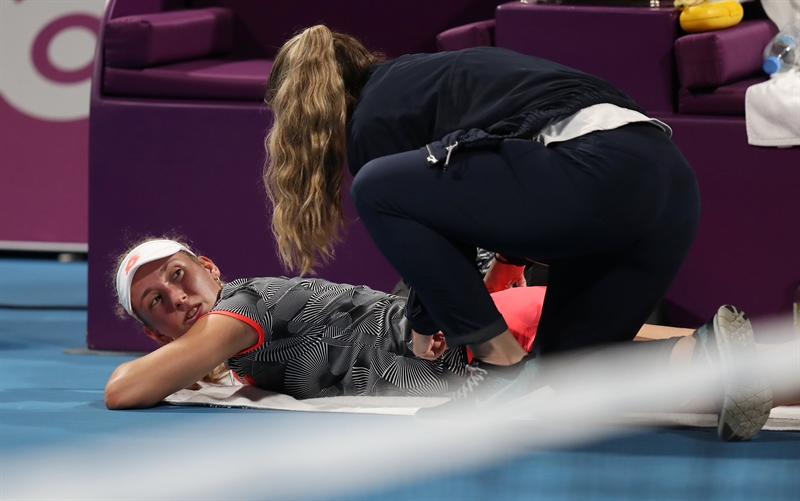Does sport influence pain perception in athletes?

In a recent article on the language of pain, physio Karen Litzy reviews how to speak to athletes about their pain. However, how good are physios in understanding a particular athlete’s pain perception and the factors that contribute to it?
In today’s newsletter, we begin a series looking at the complex factors that surround pain, an athlete’s ability to manage pain, and how effective physios are in helping manage the pain. Many athletes consider pain as an integral part of an athletic lifestyle. Pain that comes from pushing the limits of strength and endurance shows up as delayed onset muscle soreness (DOMS). Most DOMS is considered normal even when it is so painful that it inhibits normal movement patterns.
The ability of a competitive athlete to repeatedly experience this kind of transient acute pain may condition their system to tolerate pain better than non-athletes. Researchers at Tel-Aviv University compared the pain perception and tolerance of elite athletes to recreational athletes and found some interesting differences(1). Endurance athletes (n=19), strength athletes (n=17) and recreational athletes (n=17) all underwent various pain perception tests using heat and cold. In addition, they participated in standardized questionnaires that evaluated their perceived stress level, tendency toward pain catastrophizing, and fear of pain.
During the cold-water immersion test, both groups of elite athletes had lower pain rating scores than the non-elite athletes. Endurance athletes tolerated a heat stimuli longer and lower levels of fear of pain, than the other two groups. The strength athletes, however, were able to tolerate a higher absolute heat stimulus than the other groups. Overall, the elite athletes showed a better ability to withstand all pain tests than the recreational athlete group. Keep in mind; the elite athlete groups were composed of triathletes, including Ironman competitors, and strength athletes who competed at the national and international level.
What this means for the sub-elite athlete
Though the findings of the elites are interesting, more often it is the recreational or sub-elite athlete who walks into our clinic with complaints of injury and pain. In light of this population, what does this study offer? Firstly, it brings up the question of whether athletes develop resilience to pain as a result of their training, or do they gravitate toward particular sports because they inherently already possess these qualities? Both may be true.While heredity is difficult to study, some research supports the acquisition of pain hyposensitivity with increased physical activity(1). In fact, there is a phenomenon called exercise induced analgesia (EIA) that is purported to have analgesic effects up to 30 minutes after intense exercise(1). The Israeli investigators purpose that competitive athletes experience EIA with such frequency that it remains active more often than inactive, thus giving them a greater tolerance to pain.
With this in mind, it is important to keep athletes who are in pain, moving. Admittedly, some conditions require rest in order for healing to take place. However, it behooves the physio to keep an injured athlete active with some sort of adapted cross training that doesn’t exacerbate the current injury. In this study, both endurance and strength athletes showed higher pain tolerance in various categories. Therefore, one can extrapolate that either endurance or strength activities will have a benefit in helping an injured athlete tolerate pain. In particular, endurance activities may help with overall pain modulation with chronic conditions, while strength training might help with athletes who are hypersensitive or experiencing frequent periods of acute pain.
Reference
- Eur J Pain. 2018 Oct 31;1-11
You need to be logged in to continue reading.
Please register for limited access or take a 30-day risk-free trial of Sports Injury Bulletin to experience the full benefits of a subscription. TAKE A RISK-FREE TRIAL
TAKE A RISK-FREE TRIAL
Newsletter Sign Up
Subscriber Testimonials
Dr. Alexandra Fandetti-Robin, Back & Body Chiropractic
Elspeth Cowell MSCh DpodM SRCh HCPC reg
William Hunter, Nuffield Health
Newsletter Sign Up
Coaches Testimonials
Dr. Alexandra Fandetti-Robin, Back & Body Chiropractic
Elspeth Cowell MSCh DpodM SRCh HCPC reg
William Hunter, Nuffield Health
Be at the leading edge of sports injury management
Our international team of qualified experts (see above) spend hours poring over scores of technical journals and medical papers that even the most interested professionals don't have time to read.
For 17 years, we've helped hard-working physiotherapists and sports professionals like you, overwhelmed by the vast amount of new research, bring science to their treatment. Sports Injury Bulletin is the ideal resource for practitioners too busy to cull through all the monthly journals to find meaningful and applicable studies.
*includes 3 coaching manuals
Get Inspired
All the latest techniques and approaches
Sports Injury Bulletin brings together a worldwide panel of experts – including physiotherapists, doctors, researchers and sports scientists. Together we deliver everything you need to help your clients avoid – or recover as quickly as possible from – injuries.
We strip away the scientific jargon and deliver you easy-to-follow training exercises, nutrition tips, psychological strategies and recovery programmes and exercises in plain English.






